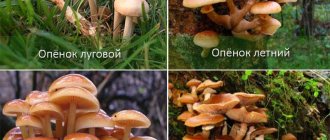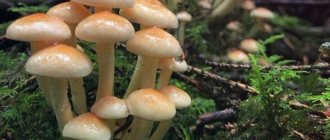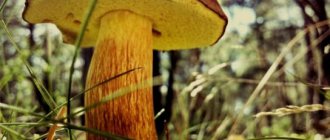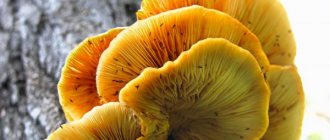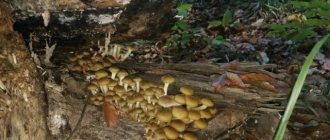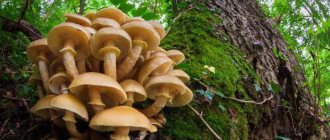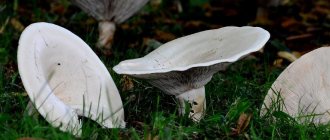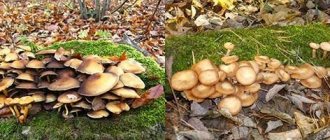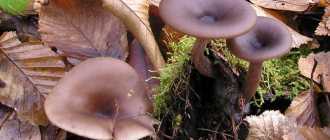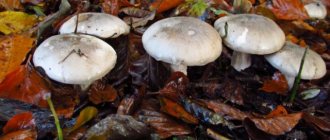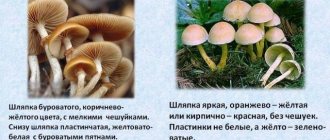It must be said right away that the talker is a rather specific mushroom. Among the diversity of its species, there are edible, as well as inedible and even poisonous species. Some mushroom pickers avoid this type of mushroom, believing that they will not be able to distinguish the edible versions from their opposites. But in vain. Mushrooms are very easy to distinguish from each other by color and smell.
Today we will look at what talker mushrooms are (photos and descriptions, how to cook them and what products they are combined with in dishes). We’ll also talk a little about where talker mushrooms grow and how to distinguish tasty mushrooms from those that are best avoided in the forest.
Where do they grow?
It is clear that before you cook talker mushrooms, you need to buy or collect them. If you are a fan of quiet mushroom hunting, then we will tell you where these representatives of the numerous mushroom world grow.
Let us immediately note that the talker is a mushroom very beloved by experienced mushroom pickers. While some species have to be literally hunted, talkers grow in entire families in large clearings. If you attack such a family, you can easily pick up a whole basket of mushrooms in one sitting.
Depending on the species, the type of area in which the mushroom grows will also change. For example, the smoky talker is very fond of pine and mixed forests. It can easily be found in the rotted leaves under the spruce on a sunny day. Whitish talkers most often grow near birch or spruce trees. There are a lot of them in the Urals and Siberia. In Crimea and in the temperate zone you can easily find reddish talkers. They are very fond of spruce and pine forests. A sunny day, an open clearing next to such a forest - and you have a whole supply of mushrooms for the winter “in your pocket” in a matter of minutes.
Types of talkers
There are a huge variety of talkers, it is impossible to list them all; of the most famous types, only the most popular can be distinguished.
Curled or red
The most famous representative of this family. It often grows in large colonies in different forests. The reddish cap grows up to 20 cm. It changes shape as it grows - in young talkers it is convex, in more mature mushrooms it is funnel-shaped, the edges are slightly lowered and curl down. The skin on the cap is smooth, yellowish-brown in color, but fades with age and becomes fawn in color with rusty spots. The yellowish leg is 15 cm long and no more than 3 cm thick. The shape is cylindrical, thickened towards the bottom.
They grow in Germany, Poland, France, Spain, Italy, Russia, Belarus and other countries of the Northern Hemisphere with a temperate climate. It bears fruit actively from the first days of July, and the last mushrooms can be found even in October. A favorite place is along the edges of paths, on forest edges and grassy meadows, in the depths of deciduous, coniferous or mixed forests on a litter of fallen leaves or mosses. They grow in arched clumps.
Orange or cocoshka
Another name is false chanterelle. There is a resemblance to a real chanterelle, but differs in its thin and dense flesh and bright color.
The mushroom cap is small, 2-5 cm in diameter; initially it has a convex shape, but over time it becomes flat, with outstretched edges, slightly curved at the ends. The color is orange-ocher, fading to pale yellow, but the middle remains bright yellow and the edges become almost white.
The leg is cylindrical, length - up to 5 cm, diameter about 0.5 cm, yellow-orange, brighter than the cap.
It bears fruit from the beginning of August to the end of October, it can be found in coniferous and mixed forests, and can grow either singly or in groups.
Only the caps of young cocos are eaten, since their legs are tough, and old caps become tough and tasteless.
Gigantic
Record holder among other species for the largest cap and stem. The mushroom is completely white. The cap usually grows up to 15 cm, but it is quite common to see mushrooms with 30 cm caps. At first it is convex, then it takes the shape of a funnel with the edges turned down. The size of the cap does not lag behind the leg. It is 4 cm thick and 8 cm long. The pulp is white and dense, but has practically no taste or aroma.
The giant talker can form “witch circles,” although it is believed that mainly poisonous representatives of the mushroom kingdom grow this way. The mycelium growing in the ground spreads evenly in all directions, which is why it occupies the area in a ring. Therefore, mushrooms grow along the border of the mycelium, located in a circle.
It grows in forest glades in North America, Europe and Russia. It bears fruit from late August to October, and can sometimes be found even in October.
Goblet
The most common in Russia. It settles on rotten wood or forest floors. Mushroom pickers go to the forest for it in August - September. The gray-brown cap is shaped like a cup or glass, with a diameter of 3–8 cm. The stem is very thin, reaches a maximum thickness of 0.6 cm, and a length of 10 cm. The pulp is watery, grayish-brown in color.
Voronchataya
It grows both singly and in groups in forests, meadows and pastures. The mushroom harvest occurs between July and October. The hat is small (10 cm in diameter). Initially, it is convex with a tubercle in the middle and curled edges. Then the mushroom gradually unfolds and forms a deep funnel, the edges of which are curved outward.
The cap is thin, light yellow or reddish in color. The leg, which has the same color as the cap, is of medium length and does not exceed 8 cm in length. At the base there is a slight thickening with white hairs. The pulp also has almond notes, is white, and not dense. The plates of the hymenophore are located frequently and strongly descend onto the stalk.
The species is widespread in the European territory of Russia, Western Siberia, the North Caucasus, as well as most European countries.
Smoky
The mushroom is found in spruce and pine forests from late summer to November. It grows in groups. The hat resembles a gray pillow. Young mushrooms may have a gray-white coating on the surface, which is easily removed. The leg grows up to 12 cm in length, 2-3 cm in diameter. There is a slight thickening at the base.
The pulp is white, has a floral-fruity aroma, fleshy, soft in young mushrooms, more fibrous and tough in mature ones.
Although the smoky talker is a conditionally edible mushroom, its consumption can cause serious harm to the gastrointestinal tract, since the mushroom contains nebularin, a cytotoxic substance.
Smoky white
Slightly different from its brother - the smoky talker. The cap of representatives of this species reaches a diameter of up to 20 cm, but usually no more than 15 cm. In young mushrooms it has the shape of a hemisphere, convex with a folded edge, over time it becomes convex-prostrate, fleshy, thick, the color is yellowish-whitish or dirty -white, can be gray in dry weather.
The leg is thick, can grow up to 8 cm in length, 1-3 cm in diameter, club-shaped, expanding over time towards the base, grayish, almost white.
The pulp is fleshy, dense, and has a characteristic fruity aroma.
It bears fruit from early September to November, but the peak occurs in September. Found in coniferous and mixed forests.
This species has some similarities with the poisonous White Row, which can be distinguished by its unpleasant aroma.
Club-shaped
An unusual mushroom that looks like an exotic jug. It settles in forests on coniferous forest floors. The convex dark gray cap straightens as the mushroom grows, diameter is 4-8 cm. The stem at the base is strongly swollen, and resembles an inverted club, length is 3-6 cm.
The pulp is ash-gray in color, but tastes very pleasant and has a pronounced mushroom aroma. Mushrooms grow in families, often fused with legs. It grows in coniferous forests from July to October, sometimes found in deciduous and mixed forests.
Fragrant
Refers to conditionally edible mushrooms, used in pickled or boiled form (cook for at least 10 minutes). It grows in coniferous and mixed forests, but is quite rare. The period of active fruiting is from the first half of September to the first half of October. The cap part of the mushroom is small, up to 6 cm in diameter, at first convex in shape, later becoming concave, with a drooping edge, color yellowish-gray or pale ocher. The stem is the same color as the cap, thin, can reach 5 cm in length, and is cylindrical in shape. The pulp is thin, watery, whitish in color.
There is a similarity with the fragrant talker, but differs from it in the yellowish color of the cap.
Fragrant
It is collected very rarely, although it is a very aromatic mushroom that smells like anise. But due to its strange bluish-green color, many mushroom pickers consider it poisonous. The cap is small - does not exceed 7 cm, flat with a tubercle in the middle. It is an unattractive bluish-greenish color, becoming gray-yellow with age.
The cylinder-shaped leg is painted, as is the cap. It reaches 5 cm in length. The plates on the lower surface of the cap part are pale green. The flesh is fleshy, but the color repels mushroom pickers - it is pale gray with a green tint. Even if you boil the mushrooms, the color will not change.
Abundant fruiting occurs from the first ten days of August to the second half of October. It inhabits deciduous, coniferous or mixed forests of Western Siberia, Central and Eastern Europe, and the European part of the Russian Federation.
Winter
The mushroom grows in the European part of the post-Soviet space; it can also be found in the Caucasus, the Far East, Western Europe, South America and North Africa. Fruiting period is late autumn.
The convex cap reaches 5 cm in diameter, later taking on a depressed shape. The edges are thin and slightly sinuous, the color of the cap is smoky or olive-brown. The cylindrical leg reaches a height of 4 cm, the color matches the color of the cap.
Snezhnaya
Some mushroom pickers claim that the snow talker is an edible mushroom, but officially it belongs to the category of conditionally edible.
The diameter of the cap part is up to 4 cm, initially it is convex, with curved edges, over time it becomes depressed, smooth, the color is gray-brownish, it can be gray-brown, the middle is darker than the edges. The leg is thin, up to 4 cm in length, cylindrical, light in color.
The flesh of the mushroom is dense, hard in the stem, and may be odorless or with a faint cucumber tint.
The fruiting period is short - from the beginning to the end of May, lives in light spruce or coniferous forests, and is not found every year.
Dangerous and inedible species
First, let's talk about what type of these mushrooms it is better to avoid. Inedible and poisonous include:
- Wax talker.
- Whitish.
- Upside down.
- Orange
By what signs can you distinguish them? Firstly, worms love any poisonous mushroom. If, for example, chanterelles, which the poisonous orange talkers are very similar to, never worm, then poisonous “versions” can very often be found literally riddled with holes.
Secondly, poisonous talkers are mushrooms (photos and detailed descriptions can be found in our article), which will always have a very pungent unpleasant odor and the same taste. It is better not to eat inedible talkers even after prolonged heat treatment. This can not only negatively affect health, but can also lead to death in people with poor health.
Poisonous properties
Previously, pigs were considered quite harmless and were often used in cooking. But since the 80s of the last century, numerous cases of poisoning began to be noted in some countries, after which doctors unanimously classified this type as a poisonous mushroom.
- Why pigs harm the body:
- Mushrooms contain a poison called lectin, which causes anemia. This occurs because the fungal toxin enters the bloodstream and causes the destruction of red blood cells.
- If the portion of the harmful substance was insignificant, an acute form of neuropathy, jaundice or renal failure may occur.
- Consumption in large doses leads to nausea, diarrhea, intoxication of the body, bradycardia, and visual impairment. Among the most severe consequences are respiratory failure and pulmonary edema.
- Also, excessive consumption of pigs causes drug addiction.
Moreover, unlike poisoning with toadstool, pig venom acts very slowly, and the first symptoms may appear after a long period of time.
They have the most detrimental effect on the child’s body. To the same extent, this applies to people who have suffered a serious illness, suffering from urolithiasis or various forms of allergies. In addition, it has been proven that the alkaloid muscarine, which is part of the red fly agaric, was found in pigs.
Important! It is strictly not recommended to use canned or boiled pigs as a snack for alcoholic drinks. This combination causes vivid, frightening hallucinations. This effect is caused by the presence of the cholinomimetic muscarine in the composition of pigs.
Edible species
As we have already said, talker is a mushroom with a specific and rather bright smell. Many mushroom pickers probably bypass it, not realizing that it is this smell that is the highlight of these forest gifts.
If you decide to collect their mushrooms and want to make something tasty out of them, then we will take a closer look at the talker mushrooms. A description of the preparation process will also be given below.
When to collect winter mushrooms
This mushroom is truly winter, since winter mushrooms appear in late autumn, in October - November. At this time it grows most intensively. Frequent thaws also promote the growth of the fungus, and in warm winters the winter mushroom season can last all three months.
When and where can you collect winter mushrooms in the Moscow region?
Flammulina velvety-footed can be found throughout Russia, and the forests near Moscow are no exception. You need to look in deciduous areas, along rivers and streams. The best time to collect is late autumn, starting at the end of September. Wet weather is especially conducive to mushroom growth. During prolonged thaws, the growth of mushrooms resumes, so you can find colonies of these mushrooms even sticking out from under the snow.
All directions except the south are considered traditional gathering places for honey mushrooms in the Moscow region.
Smoky or gray
This type of mushroom has a rather large cap, the size of which reaches up to fifteen centimeters in diameter. Initially, a small mushroom will have a convex shape; later, when the mushroom grows, the cap will become more concave. The surface of the cap, as you may have guessed, has a dirty gray or smoky color. This type of mushroom has a very pronounced fruity aroma. It will only intensify during heat treatment.
Moss honey fungus Hypholoma Polytrichi
Moss honey fungus Hypholoma Polytrichi
This species is also poisonous and is very similar in appearance to the Long-legged False Penguin in appearance and habitat.
Appearance
The cap is up to 3.5 cm in diameter, hemispherical in young fruiting bodies and prostrate in mature fruiting bodies. The cap is colored brown, sometimes with a slightly olive tint, with lighter edges. In young specimens, remnants of the veil are often visible on the cap, and in damp weather it becomes slimy.
The hymenophore is lamellar, the plates are grayish-yellow in color. The spore powder is brownish.
The leg is straight and thin, up to 12 cm long and up to 4 mm thick. It has a brownish-olive or yellow-brown tint. In young specimens, thin fibers are visible on the stalk.
The pulp is light, thin, with a weak taste and smell.
Danger level
The mushroom is still poorly studied; whether it is seriously dangerous or not is currently unknown, but officially it is classified as definitely poisonous. When consumed, it causes food poisoning - nausea and vomiting, difficulty breathing, numbness of the limbs.
Voronchataya
This mushroom with a cap of eight centimeters is also distinguished by a specific smell. This species smells like some kind of perfume composition. Mushroom pickers don’t particularly like to collect such talkers, because when cooking, the kitchen smells of old perfume that has passed its expiration date.
The outstretched shape of the cap distinguishes the funnel talker from its other counterparts in appearance. It is important to remember that this type of mushroom can only be consumed at a young age. An aging talker will be very tough and tasteless, and the specific aroma, which not everyone likes, will only intensify.
Signs of the cap edge
The edge of the cap is a continuation of its central part and its shape in many cases is an important feature necessary for accurate identification of the mushroom, and also carries information about the structure and development of the fruiting body. On the cross section of the cap, the following shapes of its edge are distinguished:
- Tucked up
, or folded down - Beveled
, or curved downwards - Straight
- Blunt
- Upbeat
- Wrapped up
The shape of the edge of the cap can change greatly with the age of the fruiting body: if the edge is tucked or bent downwards, it unfolds and becomes more and more straight; in old mushrooms it turns upward, and the area of the hymenophore increases. The edge edge also changes: if at first it is usually smooth, then with age it can become wavy, lobed, lobed-dissected, which also serves to increase the area of the hymenophore.
The edge may be sterile
, if the hymenophore ends before reaching it.
The presence and type of veil is determined by fibers, membranous flaps, and lumps of mucus on the edge of the cap.
Clubfoot
If you prefer mushrooms that have a sweetish aroma, then we advise you to pay attention to this “version” of talkers. The clubfoot is the most recognizable and commonly collected variety of edible talker mushroom. The mace resembles the stem of a mushroom. The hat of this species is quite small, one might say miniature.
This species is very popular among chefs because the product has absolutely no taste. It can be combined with absolutely any food, you can add any spices and seasonings you like. And the pleasant sweetish smell is also not repellent.
Hygrophorus mushroom: photo of white (olive-white, sweet) and brown (late) hygrophorus
Hygrophorus is a mushroom from the genus of lamellar mushrooms, predominantly of a dull, whitish color. Basically, the hygrophorus mushroom grows in meadows or forests, forming mycorrhizae with various grasses and trees.
Some types of hygrophora are edible; no poisonous varieties have been identified.
On this page you can read a description and see photos of the hygrfora mushroom of the most common varieties: white (sweet), late (brown), golden, reddish, pinkish, fragrant, larch and early. The descriptions of hygrophores of different species are similar, but there are a number of differences.
What can you cook
As with most mushrooms, many other food products can be combined with talkers. Important! Mushrooms must be heat treated before being eaten. Moreover, cooking should be quite long in order to avoid negative effects on the body. To prevent the appearance of eating disorders, we prepare mushrooms correctly, do not be lazy and do not save time.
The talking mushroom has a very specific and pleasant aroma. We'll tell you how to cook a little later, but for now let's talk about what you can cook. First of all, these are the first courses. Mushroom soups are loved by many, and the aromatic ones from talkers will find even more responses. Secondly, there are various baked goods using this product: pizza and pies, pies and filled buns. There are a lot of options for baking with mushrooms.
Thirdly, talker mushrooms are perfect for meat dishes. They go especially well with chicken or turkey. If you are following a diet menu, then these options will be simply excellent. Mushrooms are a low-calorie product that is suitable for any diet and diet. Fourthly, this type of mushroom is very often used for making sauces and gravies. There is no need to add additional aroma and taste enhancers; no extra seasonings are required. The talkers will do their job, and the sauce will turn out rich and tasty.
Signs of poisoning with false honey mushrooms and side effects
The first symptoms of false honey mushroom poisoning appear within 15-20 minutes
However, they are not always paid attention to. The stomach begins to grumble, the person complains of discomfort, a feeling of heaviness in the stomach
Symptoms gradually increase. Dizziness, heartburn and cramping pain appear, first in the epigastrium, and then spread to the entire abdomen. They are followed by severe nausea and repeated vomiting. After 2-3 hours, a person’s hands begin to tremble, weakness and drowsiness appear. The skin becomes covered with sticky sweat. Diarrhea occurs.
Another problem is dehydration. It develops due to severe vomiting and diarrhea. The first symptoms are dry mouth, viscous saliva, a constant feeling of thirst and oliguria (the patient has a sharp decrease in the amount of urine excreted). Later, shortness of breath appears, the skin becomes dry, and urine production stops (anuria). Without adequate fluid replenishment in the body, the development of acute renal failure and disturbances in the functioning of many organs and systems is possible.
If you drink alcohol, it is better to avoid mushroom dishes, as alcohol enhances the effect of toxins.
The hepatobiliary system also suffers from poisoning with false honey mushrooms. The skin takes on a yellow tint, the liver increases in size, a feeling of heaviness and pain appear in the right hypochondrium. The patient feels bitterness in the mouth.
How to cook
So, let's move on to the most important question that worries many housewives. How to cook this type of mushroom so that it is tasty and suitable for consumption. Talkers are cooked like all other mushrooms. There will be no miracles or discoveries.
Take a large saucepan and fill it with water. Pre-washed and peeled mushrooms are placed in a saucepan. Salt is added. Cook for about half an hour. You can (traditionally) add a small onion. It will be an indicator showing the presence of “bad” mushrooms among the “good” ones.
Important! Talkers only eat their caps. The legs of this species are very tough and tasteless. There is no need to pre-soak these mushrooms or soak them for hours. Just collect, wash, peel, cut off the stems and cook.
Rice with talkers and vegetables
We would like to share with you one of the many recipes, the main character in which will be talker mushrooms. To prepare this dish you will need:
- Mushrooms – one kilogram.
- 200 grams of rice.
- One liter of meat broth.
- Sweet bell pepper - a couple of pieces.
- Green peas (canned) – 100 grams.
- 200 grams of tomatoes.
- Two heads of onions.
- A couple of cloves of garlic.
- Vegetable oil for frying.
- Butter.
- One hundred grams of hard cheese.
- Salt, spices and ground pepper (to taste).
- Parsley - one large bunch.
The first thing you need to do is boil the mushrooms, as we described just above. After cooking, drain the mushrooms in a colander, add a little salt and fry in butter or vegetable oil until golden brown. In the meantime, the onions and garlic will be fried in another frying pan. We combine them with mushrooms. Simmer for five to seven minutes.
Now you can put everything into a spacious pan and add rice. Pour in the broth. And now add vegetables: green peas, tomatoes and sweet bell peppers. Vegetables can be finely chopped or chopped into long strips. Cook everything until the rice is ready.
After the dish is cooked, you can add butter, spices, grated cheese and parsley. Bon appetit!
In conclusion, I would like to say that talkers are mushrooms not only with a specific, rather pleasant aroma and rich mushroom taste. They also contain a lot of useful trace elements and minerals. Experts say that they contain substances that help relieve symptoms in patients with tuberculosis, help fight certain types of harmful bacteria in the body, and also treat epilepsy.
Why are waves useful?
They contain a lot:
- squirrel;
- minerals;
- carbohydrates;
- amino acids;
- antioxidants;
- vitamins;
- provitamins;
- lecithin.
Eating vodka is beneficial for the heart, blood vessels, and metabolism. Biologically active substances:
- stabilize glucose levels;
- cleanse blood vessels;
- relieve fatigue;
- strengthens nerves;
- normalize blood pressure;
- improve the structure of hair and skin;
- have anti-stress properties;
- support immunity;
- stimulate brain function,
- improve vision.
Low-calorie volushki relieve excess weight without the pangs of hunger, tone the body for an active life.
